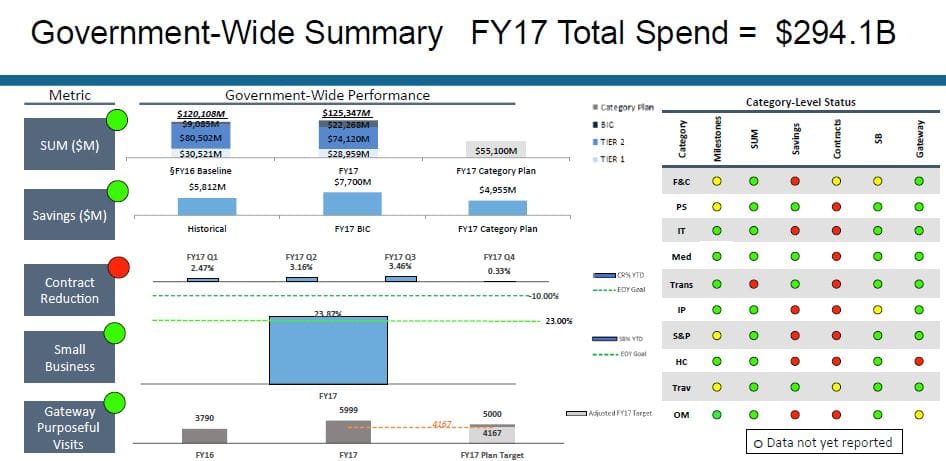

The Office of Federal Procurement Policy determined each category should target 13 percent-to-50 percent of their spending to small firms.
This is part two of a two-part look at OFPP’s version 3 category management strategies. In last week’s Reporter’s Notebook, I looked at the goals of the new strategies such as attempting once again to reduce contract duplication.
The small business community has a right to be concerned with the Office of Federal Procurement Policy’s reinvigorated category management initiative.
History hasn’t been kind to small firms when it comes to big, bold initiatives to better manage spending or reduce costs, or, as is the case for category management, all of the above and more.
The small business community remembers OFPP’s strategic sourcing efforts. The Obama administration talked a good talk about small businesses winning a bigger piece of the pie in areas such as office supplies. But the administration failed to recognize that smaller number of firms winning a larger percentage does as much harm to the industrial base as a larger number winning a smaller percentage of contracts.
With the Trump administration’s latest set of category management plans, small business is one of four main focus areas across the 10 spending categories, which agencies spend more than $294.1 billion a year on.
According to version 3 of the strategic plans, which Federal News Radio obtained, OFPP and the Category Management Leadership Council (CMLC) determined each category should target 13 percent-to-50 percent of their spending to small firms. The goals include 39 percent in the IT category, 50 percent in the office management area and 33 percent for professional services.
But the plans also raised serious concerns from the federal small business directors about whether category management and small business as a socioeconomic policy can live in harmony. So far, the harmony has been hard to come by as a recent study found the number of small firms winning prime contracts is down by 25 percent since 2010.
“While the committee is encouraged by the expressed of the Office of Federal Procurement Policy to further small business goal achievements, the committee’s review identified opportunities to strengthen aspects of the general approach of the plans to promote small business participation,” wrote Denise Sirmons, chairwoman of the committee and director of the OSDBU office at the Environmental Protection Agency, in a letter to OFPP, which Federal News Radio also obtained.
The Office of Small Disadvantage Business Utilization Council’s category management committee, and Robb Wong, the associate administrator in the Small Business Administration’s Office of Government Contracting and Business Development, wrote to OFPP detailing recommendations to make the strategic plans more responsive to small business concerns.
The recommendations include:
Stacy Riggs, the acting director for the category management governmentwide program management office, said in an email to Federal News Radio that the OFPP, the SBA and the OSDBU Council have been collaborating to “align goals, collaborate on improvements and develop data intelligence to ensure agencies can continue to meet their small business procurement goals as they implement category management principles.”
“We also have developed tools and dashboards to help agencies understand and optimize their usage of well-managed contracts, and to find identify small businesses to meet their needs,” she said. “Moving forward, we will continue to work with OSDBUs, SBA and across government to grow existing capabilities (e.g., governmentwide category management dashboards, all small Mentor-Protégé Program, 8(a) Business Development Program, best-in-class contract on- and off-ramping, and supporting policies) and innovate new methods for maximizing opportunities for small businesses.”
Lesley Field, the acting OFPP administrator, also expressed the commitment to small firms.
“We have conducted a deep analysis of the current state on all BICs. Currently 45 percent of spend and 75 percent of the vendors are small business,” Field said in an email to Federal News Radio. “Many of the best-in-class solutions have pools or groups that are set aside exclusively for small business (e.g., OASIS and BMO). Other best-in-class solutions allow set asides at the order level, consistent with existing regulations and the Small Business Jobs Act. Several of the best-in-class contracts have on/off ramps.”

Field said category managers have identified requirements for a BIC finder tool that will let agencies more easily determine what BICs are available to meet small business needs. The tool even lets contracting officers search for set-aside and socioeconomic category set-aside options.
She added OFPP and the category managers have “compiled all details regarding small businesses on BICs, including spend, vendors, types, on-ramping, terms and conditions.”
In fiscal 2017, OFPP says 7 of 10 categories met or exceeded their small business goals.
But what Field and Riggs are missing is details about how they will hold the category managers accountable given shortcomings in the data.
Jack Kelly, a former OFPP analyst, who retired after 36 years in government, reviewed the new strategies and said there needs to be more specific data in each category.
“One of things each category should have is a small business participation strategy that lays out fundamental things like the number of small businesses available in this part of the supply chain, how much goes to small businesses and how much goes to large businesses currently,” he said. “One of things that always killed me about the government’s small business policy is we always talked about increasing the share of spending going to small businesses, but what I want to know what is the potential spend? We don’t know that. We could be close to the maximum of potential spend so pushing beyond that may not make sense.”
Kelly said when it comes to small business contracting, one-size does not fit all, which is why collecting the data on the current status of the industrial base is so important.
Joe Jordan, a former OFPP administrator for the Obama administration and now an independent consultant, said drilling down in each of the socioeconomic categories would be an important addition to the strategies to help address the potential impact on small firms.
“Where the strategies talk about best-in-class contracts, having on-ramps and holding them frequently is critical,” Jordan said. “You have to give new entrants the ability to access these opportunities and folks who are not delivering BIC results need an exit from these vehicles. It’s very hard to do, but that’s got to be a collaborative focus to make it work. The number of small businesses on a contract vehicle is not where the inefficiencies are as long as there are good ordering mechanisms and you have a good set of terms and conditions.”
Jordan said this is an area where Congress may even be helpful by focusing on metrics to ensure maximum small business participation and whether its total dollars or total number of companies participating.
Jordan said OFPP and the category management council need to pay close attention to the continued tension with small businesses. He said he recognized the flash point with strategic sourcing and came around to understand that measuring the percentage of dollars given to small businesses was not as good of a metric as measuring the number of small businesses receiving contracts.
Maybe that’s a lesson OFPP should heed?
Copyright © 2025 Federal News Network. All rights reserved. This website is not intended for users located within the European Economic Area.
Jason Miller is executive editor of Federal News Network and directs news coverage on the people, policy and programs of the federal government.
Follow @jmillerWFED



